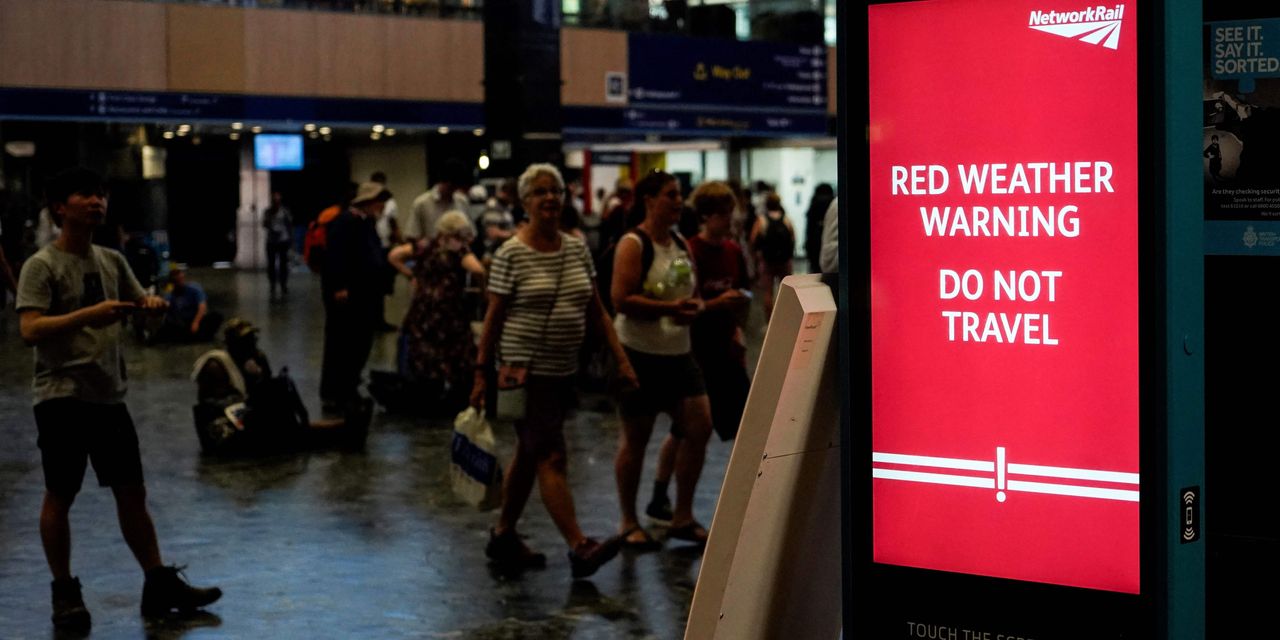Two years ago, with meteorologists quickening the rate at which they try to warn the world of the perils of unchecked climate change, the U.K.’s Met Office — the official weather forecasting agency for the country — posted an alarming, red-splashed temperature map. It was meant as a teaching tool.
The Met Office imagined, as a strict hypothetical, what July 23, 2050 might feel like for this far-northern, populous island nation and its Irish neighbors. This was based on climate change projections and what is known so far about global warming’s impact — not in strictly causing weather extremes, but in boosting their frequency and severity.
“Not actual weather forecast,” the graphic made clear. “Examples of plausible weather based on climate projections.”
But this week, the Met Office no longer had to pretend. The severe heatwave was here — 28 years early.
On Tuesday, for the first time in its recorded history, London’s main airport, Heathrow, registered a temperature north of 40 degrees Celsius.
Here’s what that looks like for those used to a Fahrenheit thermometer. For starters, the record-setting 40 degrees Celsius equates to 104 degrees Fahrenheit. Although as one London-based, American-born MarketWatch colleague reported: It’s hot as hell, but no humidity!
London in the south to Manchester, and Leeds in the north, remained under the country’s first warning of “extreme” heat Tuesday, meaning there is danger of death even for healthy people.
U.K. train operators warned the heat could warp the rails, and some schools and daycares set up wading pools to help children cool off in a country where air conditioning is rare. At least five people were reported to have drowned across the U.K. in rivers, lakes and reservoirs while trying to find some relief, the Associated Press reported.
Studies have shown that the likelihood of temperatures in the U.K. reaching 40 degrees Celsius (104 degrees Fahrenheit) is now 10 times higher than in the pre-industrial era, the Met Office says.
The dangers of extreme heat were on display in parts of continental Europe, too. At least 748 heat-related deaths have been reported recently in Spain and neighboring Portugal, where temperatures reached 47 degrees Celsius (117 degrees Fahrenheit) earlier this month.
Read more from the U.K.’s Met Office on the “wavenumber 5” pattern in surface temperature that explains why so many heatwaves are seen across the similar latitudes, and the long-run impact of climate change on heat.
Wildfires in Spain and France, made worse by the heat and drought, forced thousands of people to be evacuated. Two people were killed in the blazes in Spain that its prime minister linked to global warming, saying, “Climate change kills.”
And in the U.S.? Since the 1980s, there have been three daily record high temperatures for every two record lows, according to the National Weather Service. Hot weather impacts everyone, but is most taxing on first responders and those working outside, as well as elderly people, young children and folks already experiencing compromised respiratory issues.
Signs show this may only be the beginning.
If greenhouse gas emissions, linked to the burning of oil
CL00,
gas and other fossil fuels, are not significantly curtailed, daily high and low temperatures will increase by at least 5 degrees Fahrenheit in most U.S. areas by mid-century, rising to 10 degrees Fahrenheit by late century. In fact, the National Climate Assessment estimates 20-30 more days over 90 degrees Fahrenheit each year in most U.S. areas by mid-century.
Read more on heat extremes:
Severe heat: 5 electricity blackout risks facing the entire U.S., not just Texas
Why you, and your wallet, must get used to heatwaves
Don’t rule out natural gas in the clean-energy transition, trade group says
The top U.S. cities labeled as dangerous ‘heat islands’ include a few small-population surprises
